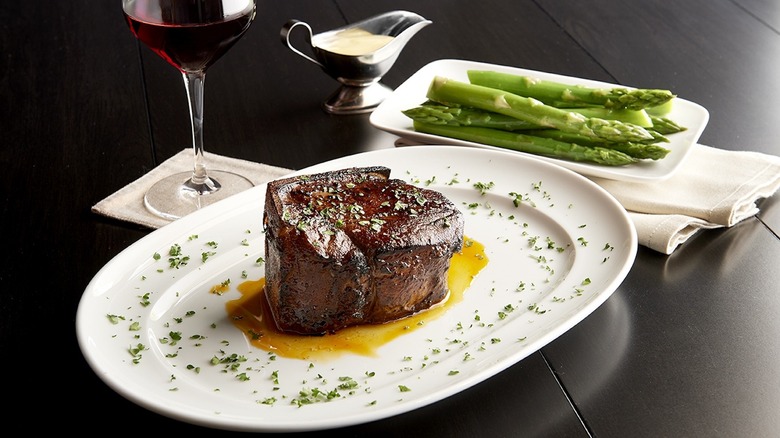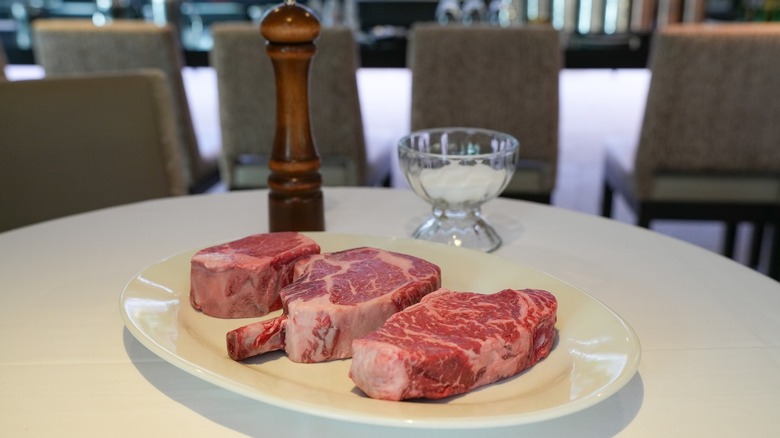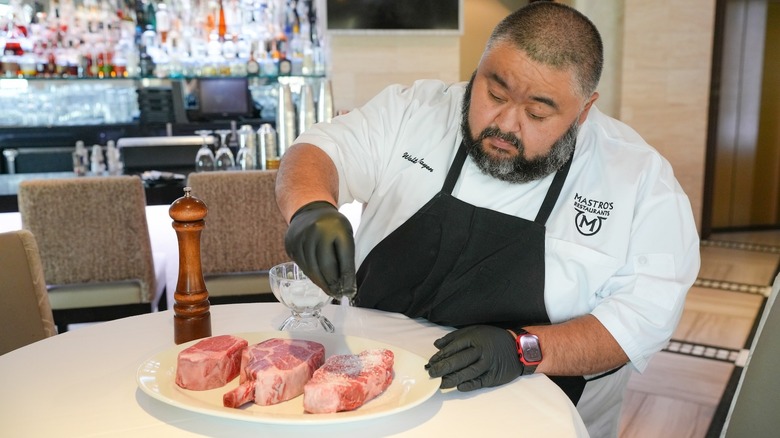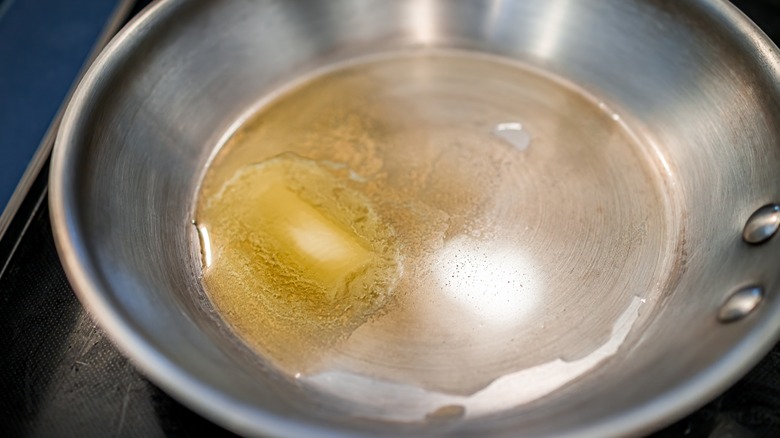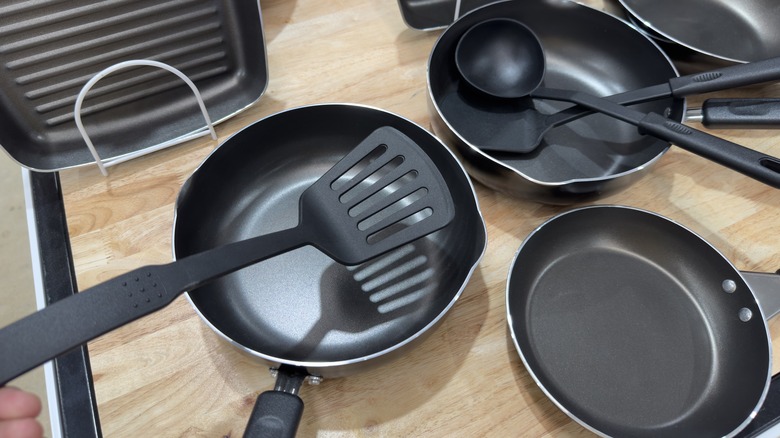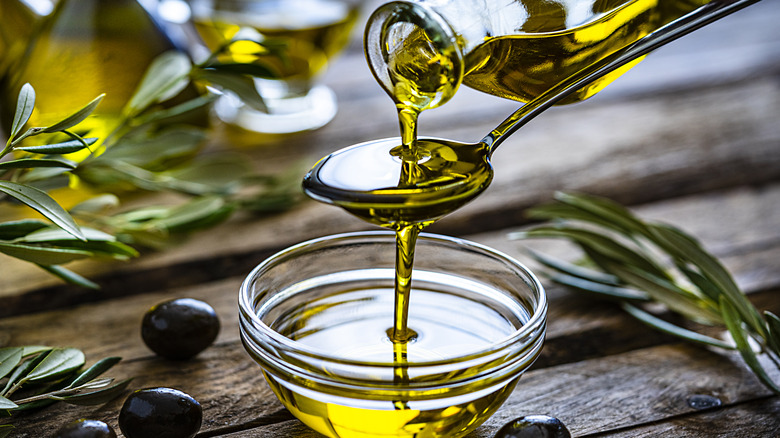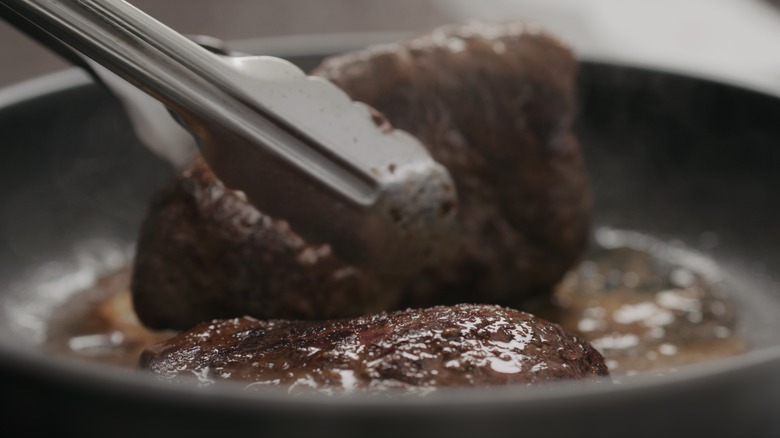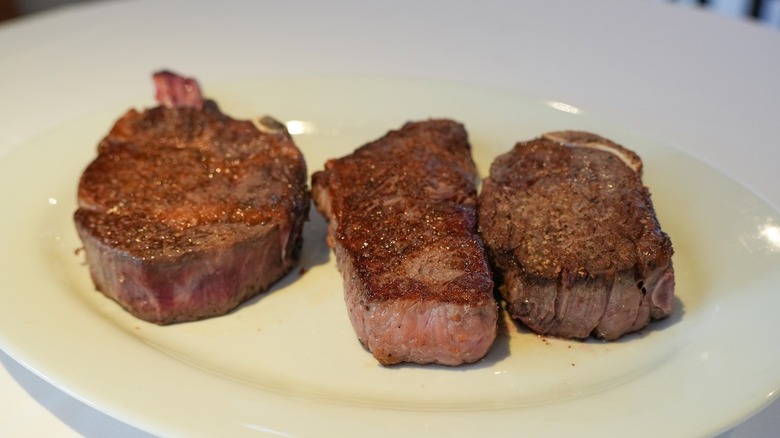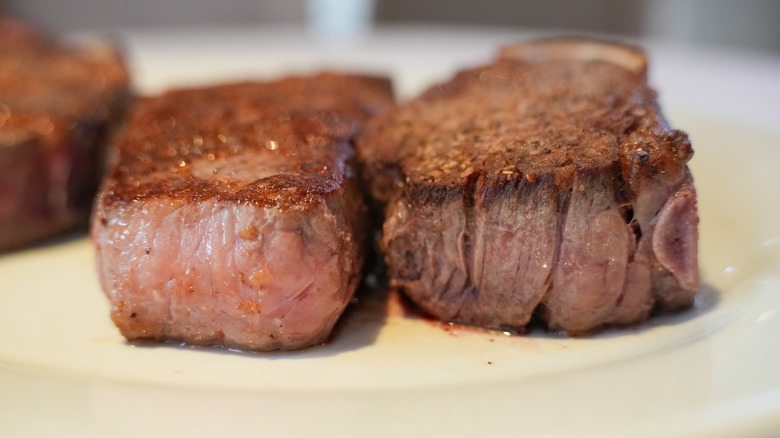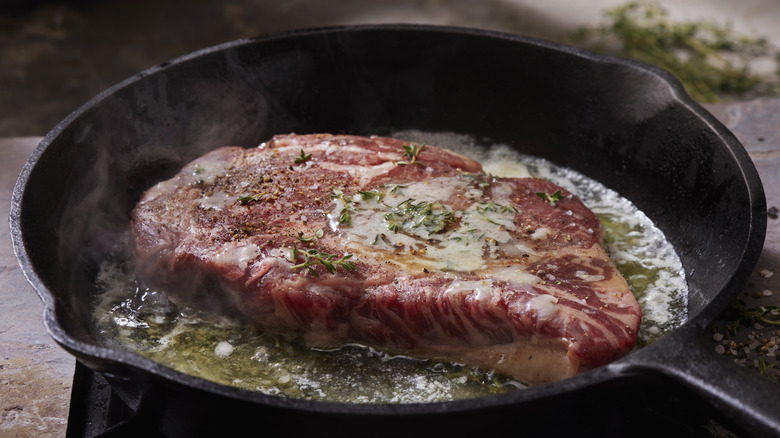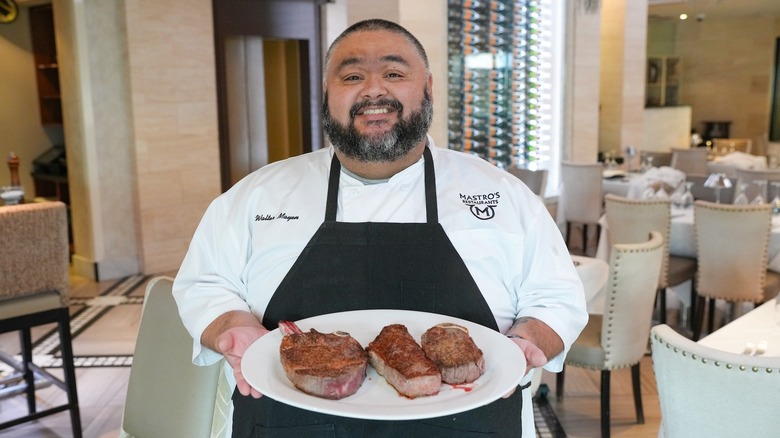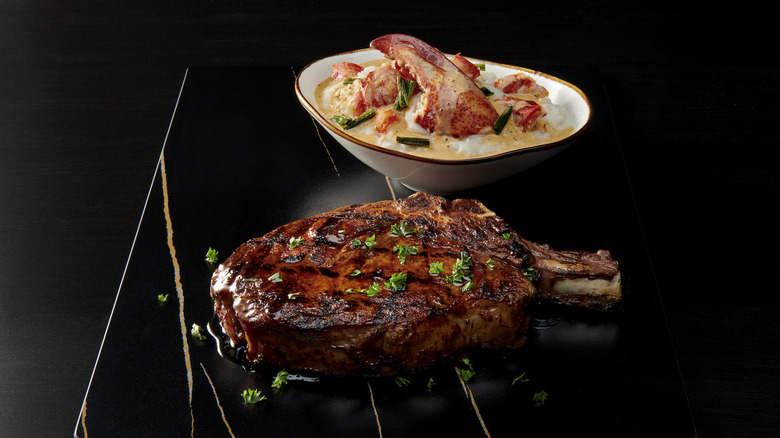How To Make A Superior Steak, According To Mastro's Executive Chef
A steak seems like a deceptively simple meal to make, but as anyone who has tried to cook one at home knows, there are actually a lot of ways to mess it up. That being said, there are also an equal number of ways to improve your steak game as well, with a few good tips from those who have mastered the art of meat preparation.
In order to get to the bottom of how you can cook a superior steak, we spoke to Executive Chef Walter Mayen of Mastro's Steakhouse in Beverly Hills. Mastro's has been ranked on multiple lists as one of the best steakhouses in Los Angeles, if not the entire state.
Chef Mayen told us some insider chef's tips, as well as his personal methods and preferences when it comes to preparing steaks. He also went over some frequent mistakes people make when cooking at home, as well as subtle ways to massively improve the flavor of your final product. Whether you're trying to find out what seasoning works best, how to get a perfect sear, or how to get the right temperature on your pan, this article will answer almost all your steak-related questions.
Use the cuts and seasonings you prefer
Different cuts of steak will give you different textures and flavor, but at the end of the day, there is no one right choice, just the one you prefer. As Chef Mayen says, "if you like a lean steak, stay with a filet, if you like a fatty steak, the ribeye is one of the best cuts you can get."
Same with seasonings, as only you know what works best on your palate. As far as Chef Mayen is concerned, "sea salt and pepper are always the best way to go, you can never go wrong with that; you can always make your own dry rub with different herbs and different flavors, but I always tell people just do what you like". One of the seasonings he personally likes using in his steaks is tarragon. It has an herbal flavor that complements the meat really well.
Careful what marinade you use
Instead of a dry rub, some people prefer to use a wet marinade to impart flavor into their steak before preparing it. That being said, there are certain marinade ingredients you want to be careful with when preparing meat. "Stuff with high citrus like papaya, pineapples, you don't want to let your steaks marinade too long, because it'll just break down the muscle enzymes in it, and you're going to get a very mushy steak", as Chef Mayen says. That's why he recommends not letting your steak soak in citrus marinades for more than an hour.
Some great non-citrus wet marinade ingredients include Worcestershire sauce, honey, bourbon, and balsamic vinegar. If you're using these marinades, you can let your steaks soak in them for a longer amount of time before placing them in a pan for up to two, three, or four hours. Depending on the ingredients you use, you can infuse your steak with flavors from a wide range of cuisines, anything from East Asian-inspired soy sauce marinades to spicy Mexican ingredients.
Check the temperature on your pan
A grill may be the ultimate way to cook a steak, but a lot of people living in apartments or urban areas in general don't have access to grills. Not to worry, as a stovetop will do just fine. If you're using a pan, you want to make sure it's hot enough to cook a steak without being so hot it burns it.
To check the temperature, Chef Mayen uses what he calls the "water dance" method. "Grab a little water with your fingers, just drip it over the saute pan, and when you see that water kind of start moving around but it's not evaporating, you see it kind of dancing; that's the perfect state."
No matter what the dial on your stove says, you also want to make sure the heat in your pan is consistent while your steak is cooking. There should never be smoke or anything more than a light vapor coming off the meat. Smoke means your pan is way too hot. Ideally, you want to see the oil around the steak softly bubbling in the pan. As Chef Mayen says, "You see the oil nice and bubbling around the steak, and you hear that nice bubble and the oil doing its work and its magic."
Adjust your cooking methods to your pan
Most people have experienced the aggravation of cooking at someone else's house for the first time. You may use the same temperature for your food, for the same length of time you cook it at home, yet suddenly you find you've burned your meal. The answer to why this happens probably lies in the fact that your pans at home are different from the pans you're using elsewhere.
As Chef Mayen says, "If you're going to use nonstick, just make sure again, the heat ratio on that one is going to be very different." It can be incredibly hard to sear a steak with a nonstick pan, as you generally have to heat it at a lower temperature than regular pans. Also, if you prefer iron skillets, make sure you season them perfectly and maintain them exceptionally well; otherwise, there's a chance your steak will end up with a slightly rusty flavor that you definitely don't want.
The oil you're using matters
Before you even start searing your steak, you will need to have some oil sizzling in your pan. Thanks to different smoke points, the oil you choose to use can actually make a big difference. "I try to stay away from oils like grape oil because they sometimes don't have a high burn content, so they can sometimes burn the steak", says Mayen. "I prefer a little bit of canola and a little bit of olive oil, EVO, just extra virgin olive oil, just a little mixture of both of them."
Extra virgin olive oil has a relatively high smoke point, which makes it an excellent, versatile option for all kinds of cooking, especially for searing steaks. Canola oil also has a pretty high smoke point, clocking in at around 400 F, and it tends to be a bit healthier than vegetable oil. That's mostly because canola oil has much fewer saturated fats and trans fats than other vegetable oils.
Don't move your steak around too much
Though you want to feel like you're helping the cooking process along, interfering too much while the steak is cooking by moving it around can actually dry out the final product. Mastro's executive chef says this is one of the most common mistakes cooks make; "just put the steak on the saute pan and just let it go, let it be. Don't touch it, don't move it, just let it marry with the pan and become one."
According to Chef Mayen, it helps to think of the steak as a water level. Cooks who repeatedly flip their steaks are going to dry up the insides because the steak will cook up to a certain level, but not all the way through, and then lose heat again after you've flipped to the other side. You will end up overcooking the meat to finally be able to get a nice sear on each side if you're even able to past a certain point. "If you keep flipping it and it hasn't got that nice sear, all that moisture inside is just gonna keep escaping on your steak," says Mayen.
Make sure you get a perfect first sear
Speaking of sears, they may be the ultimate key to preparing a superior steak. After you have that perfect first sear on your steak, your job is 80% done, according to Mayen. "Once it forms that beautiful crust and it gets that beautiful sear when you flip over that steak, it's going to be so easy, it's going to flip over so well, and you're going to get that nice beautiful crust on top of the steak."
If you've seared your steak correctly, at the right temperature, it shouldn't be sticking to the pan when you try to flip it over. A good sear acts like a blocker, helping seal in the steak's moisture and flavor throughout the cooking process. This is especially important if you want a more medium to well-done steak or are working with a thicker cut and plan to finish off cooking the meat in your oven. After that first sear is done, you can breathe a nice sigh of relief.
Adjust for steak thickness
Though an average steak needs around five minutes per side to get a nice sear, the time each cut needs on a stovetop depends on thickness. For a cut that's one inch thick, for example, Mayen recommends about three to four minutes per side, while for something bigger (two to three inches thick), you would sear it for five to seven minutes on each side. If you want it well done, or even medium well, it's best to throw the steak in the oven after searing it, in order to cook it thoroughly without drying it out.
The one thing you want to watch out for is ultra-thin cuts, around a half-inch thick. Chef Mayen warns that you will want to do a "three-minute cook on one side to get a nice sear, but on the flip, you might only do a minute to a minute and a half because you don't want to cook it too much in the pan because that heat is already gone through a good majority of that steak so that flip is just getting that last part on the other side of the steak."
Add butter only at the very end
Many people like to melt butter over a finished steak, but you can get the meat to absorb even more of that nutty aroma and flavor if you use butter in the cooking process itself. However, because butter burns faster than oil, you're not going to want it in the pan the entire time the steak is cooking. Rather, you should add it in at the very end, when the steak is almost done, and then baste the steak with it.
After you add butter to your pan, "just tilt it to the side and just start basting your steak with a spoon...overlap it for a good couple of maybe two, three minutes, and then once you get to that perfect kind of color that you want, and the butter is not burnt, you're going to take that steak out". If you do leave the butter in too long or try to insert it from the beginning of the cooking process, you will likely end up with an unappetizing-looking (and tasting) black film of butter in your pan.
The right temperature is the one that works for you
If you think a great steak chef will get mad at you for preferring your meat medium well or even well done, think again. Chef Mayen has seen many customers thinking he will disapprove of anything but a medium rare steak, which is the most popular way to order and cook steak in the U.S., with 36% of people in one survey preferring this temperature.
However, as the chef says, "As long as you're enjoying it, at the end of the day, that's all that matters. As long as you're happy with the steak and you're happy with the outcome, what else can be wrong?" Many cultures prefer well-done steaks, and people who like to live on the wild side and order their steaks rare.
Often, as people get accustomed to eating steaks, their preferences may even change over their lifetime, from well done to medium, for example. One of the best things about steaks is that you can almost completely customize them to your preferences, as you have seen when it comes to cuts and seasonings in this post, so why should the temperature be any different?
Let the steak rest for 10-15 minutes
Never skip this step, as letting your steak rest is important for maintaining the moisture and juices of the steak. A lot of great cooks prepare a perfect steak and then ruin all their good work by getting impatient and cutting into it immediately, letting a lot of the juices (and flavor) out of their beautifully prepared meat.
"Once it sits for about a good ten, fifteen minutes, that's when you want to slice it, or, place it on a plate if you want to eat it nice and whole", Chef Mayen says. This allows the muscle fibers of the steak to contract while cooling down, which is the scientific reason the steak is better able to hold onto its juices while resting. If you do cut it before preparing it, you will want to slice it against the grain of the steak for optimal results.
